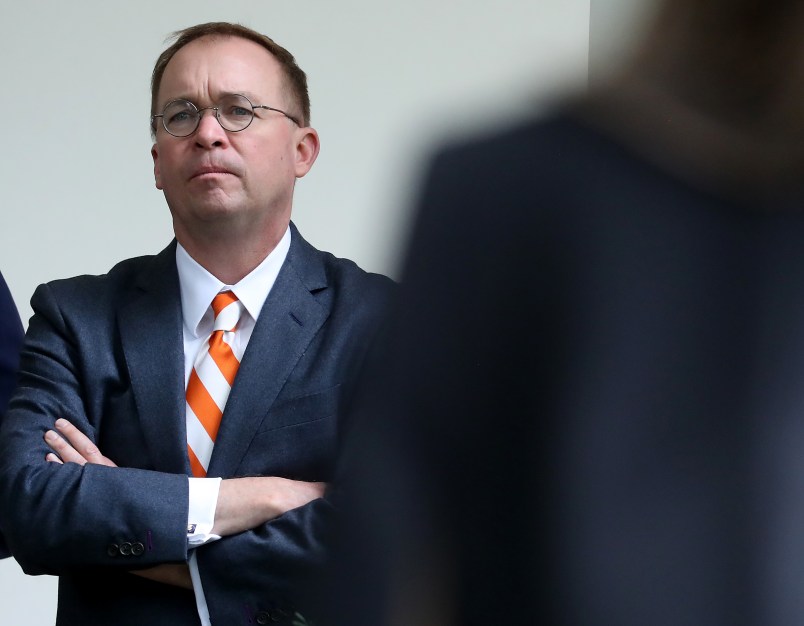Even as dozens of government officials dished publicly on President Trump’s campaign to extort Ukraine, impeachment investigators could not penetrate one key inner circle: people who were there when Trump ordered that $391 million in military aid be frozen.
In fact, as a report released by the House Intelligence Committee on Tuesday shows, nobody who bore direct witness to Trump ordering the freeze itself obeyed congressional demands for testimony or documents about the hold, which is among the most explosive elements of the drama that is likely to lead to the President’s impeachment.
It is also the element of the probe that most seriously implicates U.S. national security interests in supporting Ukraine as it attempts to negotiate an end to a long war with Russian-backed proxies in its east.
But for an allegation so central to the impeachment inquiry, the House’s most direct source is someone copied on emails written and sent by those who refused to testify.
Office of Management and Budget national security staffer Mark Sandy told Congress in a Nov. 16 closed-door deposition that his bosses communicated about a decision by Trump made in July to place a hold on the security assistance. House investigators cite Sandy’s testimony alongside that of others who had heard secondhand that the President himself ordered the freeze, but did not bear direct witness to it.
The level of removal further suggests that those closest to one of the most stunning allegations against the President will not comply with congressional demands to provide evidence, while also continuing to shroud key questions about the rationale for the hold.
The House addressed the refusal of top Trump administration officials to cooperate in a section of the report focused on “the President’s obstruction” of the congressional investigation. Impeachment investigators wrote that OMB chief Mick Mulvaney, among others, “may have placed themselves at risk of being held in criminal contempt of Congress” by refusing to cooperate with the probe.
But it was Sandy, the only OMB official to cooperate with the investigation, who has provided the most detail on Trump’s involvement in issuing the order to freeze the aid.
On June 19, Sandy testified, he was copied on an email from his boss, political appointee Michael Duffey, to the deputy undersecretary of defense communicating that Trump “had seen a media report and he had questions about the assistance” to Ukraine, and that “the President had questions about the press report and that he was seeking additional information.”
Then within hours — and a day after the Pentagon announced the $250 million in security assistance to Ukraine — Trump gave an interview to Sean Hannity in which he brought up the same conspiracy theory about Ukraine that he would later press the Ukrainian president to investigate.
If the White House had cooperated with the impeachment inquiry, Duffey likely would have faced inquiries about what specific “questions” President Donald Trump had about Ukraine. If Duffey’s office would have provided the email he sent the Pentagon, and the follow-up questions he asked about the assistance, congressional investigators would have had more to go on than Sandy’s memory.
“We did get that series of questions just within a few days after the press release and after that one article that had the headline,” Cooper testified, referring to news coverage of the Ukraine aid.
The Defense Department did not comply with congressional subpoenas for emails Laura Cooper recalled receiving “a few days” after the Pentagon announced the $250 million package on June 18.
It was soon after the initial June 19 White House email asking about the Ukraine money, witnesses testified, that Trump acted to stop the flow of money to the country.
By July 3, the White House budget office had informed the State Department that it would not be allowed to transmit a legally required notice to Congress regarding an upcoming release of funds.
By July 12, Trump had ordered a broader hold on the Ukraine aid.
“The President is directing a hold on military support funding for Ukraine,” Sandy testified that he was informed by Robert Blair, an aide to White House chief of staff Mick Mulvaney and Sandy’s old boss in the budget office.
Blair and Mulvaney could be important witnesses to the reasons Trump gave for directing the hold, but they obeyed orders not to testify. Sandy said Blair only gave him a justification for the hold weeks later, in September, just before Trump released the money.
The impeachment inquiry report released Tuesday raises even more questions that White House witnesses and documents kept away from the investigation might be able to answer.
The largest question mark is perhaps represented in the call logs obtained by the committee. On Aug. 8, after Trump’s hold on the Ukraine money had become widely known within administration, Trump’s personal lawyer Rudy Giuliani “texted several times with a number associated with the White House,” according to the report.
“In the mid-afternoon, someone using a telephone number associated with the Office of Management and Budget called Mr. Giuliani, and the call lasted for nearly 13 minutes,” the report said. “Mr. Giuliani called the OMB number and the White House Situation Room several more times that evening, but each time connected for only a few seconds or not at all.” Giuliani then texted a White House-associated number.
Who at the White House did Giuliani call? And what did they talk about? The White House has succeeded so far in stonewalling those kinds of questions.











